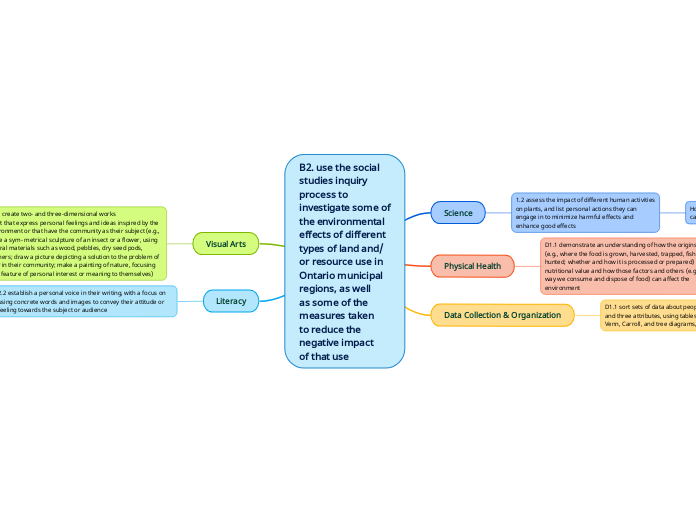B2. use the social
studies inquiry
process to
investigate some of
the environmental
effects of different
types of land and/
or resource use in
Ontario municipal
regions, as well
as some of the
measures taken
to reduce the
negative impact
of that use
Science
1.2 assess the impact of different human activities
on plants, and list personal actions they can
engage in to minimize harmful effects and
enhance good effects
How can students reduce the negative impacts and how we can use plants to better the environment
Physical Health
D1.1 demonstrate an understanding of how the origins of food (e.g., where the food is grown, harvested, trapped, fished, or hunted; whether and how it is processed or prepared) affect its nutritional value and how those factors and others (e.g., the way we consume and dispose of food) can affect the environment
Talk about the process of how we get plants
Data Collection & Organization
D1.1 sort sets of data about people or things according to two and three attributes, using tables and logic diagrams, including Venn, Carroll, and tree diagrams, as appropriate
Look into the data on environmental impacts and how we can reduce the impacts
Visual Arts
D1.1 create two- and three-dimensional works
of art that express personal feelings and ideas inspired by the environment or that have the community as their subject (e.g., make a sym- metrical sculpture of an insect or a flower, using natural materials such as wood, pebbles, dry seed pods, feathers; draw a picture depicting a solution to the problem of litter in their community; make a painting of nature, focusing on a feature of personal interest or meaning to themselves)
Instead of composting old leaves, sticks etc. explore ways to use them in our art projects
Literacy
2.2 establish a personal voice in their writing, with a focus on using concrete words and images to convey their attitude or feeling towards the subject or audience
Can write about what their impacts are on the environment
